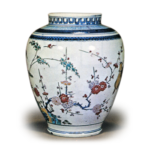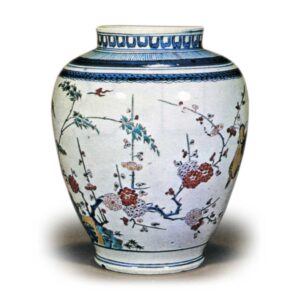
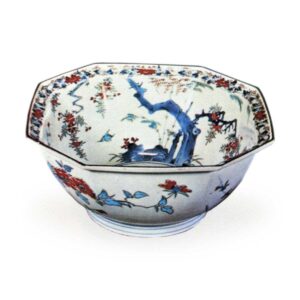
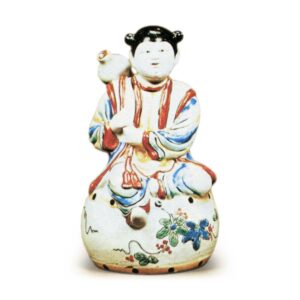
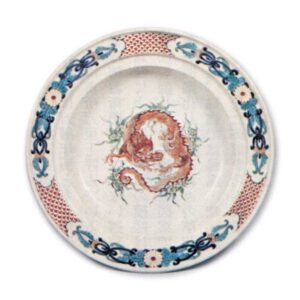
A potter from Minamikawara, Hizen Arita (Saga Prefecture, Nishimatsuura District, Arita Town, Kyokugawa). His family name was Sakaida. Kakiemon is the founder of red glazed porcelain in Japan, and there are now thirteen generations of Kakiemon. Kakiemon I, initially called Kisanemon, was born in 1596. He learned about Takahara Goroshichi (Takehara) from his father Enzai, and studied blue-and-white porcelain in Minami-kawahara in 1617 (Genna 3). Later, when Higashijima Tokuemon, a native of Imari, learned from a Chinese how to color porcelain with gold, silver, and mud, they often tried the method together without success, and finally consulted Kuresu Gombei, who finally obtained the method. After consulting with Kuresu Gompei, he finally obtained the method and applied it to his own porcelain and took it to Nagasaki, where he sold it to the eight officials of the Qing Dynasty in China. This was the first time Arita porcelain was sold overseas, in June 1646 (Shoho 3).
He died in June 1666 at the age of 71. The name was passed down from generation to generation, and the eldest son of the first generation succeeded the second generation, but he died prematurely in 1661.
His works were the same as those of the first generation. The fourth died in 1679 (Enpo 7), and the fifth in 1691 (Genroku 4). Both died relatively early in life, and their skills seemed to have declined several notches, so the kiln was temporarily closed when the fifth generation died. The sixth died in 1735 (Kyoho 20). The seventh died in 1764, the eighth in 1781, and the ninth in 1836. Although the details of his life during this period are not known, it seems that Okawachi potteries became more prosperous at that time, and he was the leading potter in all of them. The 10th generation died in 1860, and the 11th Shibunosuke died in February 1917. Kakiemon Limited Partnership was established during the Taisho era (1912-1926), but the 12th generation left the company in 1928 (Showa 3).
The porcelain generally referred to as Kakiemon is clearly the work of Kakiemon Sakaida, but its production is a kind of craft, and it is not the work of a single individual, but rather the work of many craftsmen. Therefore, the works should be referred to as those produced at the kiln of the Sakaida family, using the techniques, glazes, and materials handed down by the Sakaida family. Therefore, it is not possible to say for sure which generation produced each piece, but only to identify the approximate age of the piece.
Characteristics: The pieces described here are from the first to the third generation. Kakiemon I had already produced blue-and-white porcelain, which today is usually confused with indigo-painted Ko-Imari. The essence of Kakiemon I is not in the blue-and-white porcelain but in the gorgeous nishikite. The second characteristic is the use of colored glazes for overglaze painting, of which there are an extremely wide variety, the most common being red, green, gold, yellow, blue, purple and black, with silver also used. Of these, the use of red was the most difficult. It blends well with gosu, and although it lacks the solemnity of Ko-kutani, it has an elegant characteristic. The green and yellow colored glazes are always the mainstay of Kakiemon’s work. The gold is not as thick as in the case of Nikiyoe, but is pure and hard-baked. The third is the pattern and design. These can be broadly classified into three types. The first type is based on or imitated Kangxi red paintings of the Qing Dynasty in China, the second type is based on Kangxi style designs, and the third type is purely Japanese in style, and the third type is Western style influenced by the Netherlands. The oldest Ko-Imari is no other than Kakiemon. The purely Japanese style patterns designed by Kakiemon are extremely elegant, departing from the rich design of the Chinese style, and most of them are decorated with plum and chrysanthemum, various flowers and grasses, bamboo, palms, maple, oak, pine, and animals such as phoenix, dragon, deer, tiger, small bird, and human figures, and also skillfully depicted bush fences. Next, under the influence of the Dutch, he digested glass, pottery, chintz and other patterns obtained through trade at that time, and applied graphic patterns of flowers, plants and birds. The fourth characteristic of his painting is his use of green and yellow to depict leaves and rocks, for example, and his use of thin black lines to outline the outline of animals. The red line is the ultimate in skill.
When Kakiemon’s works entered Europe through the Dutch trade, they were welcomed as more than Chinese porcelain, and in Delft, Holland, in particular, several professional imitators were produced. The French called Kakiemon “the world’s first-rate nishikite”.
According to the Sakaida family, however, the Kakushi Fukushi seal was used, and the “rice field” part of the Fukushi character had a spiral shape. In 1885 (Meiji 1885), this was registered as a trademark, but in 1928 (Showa 1928), Kakiemon XII withdrew from the Kakiemon Limited Partnership, and the “Made in Kakiemon” name was changed to “Made in Kakiemon”. The Kakufuku mark became the property of Kakiemon Goshi Kaisha. The inscription “Genroku nen Kaki” was probably made by Sakaida Shibuemon, a master craftsman who was the guardian of the sixth generation. (Kogei Kagami, Nihon china shishi ron, Kakiemon to shiro nabeshima, Yakimono zuishitsu, “Sakaida family record”)

